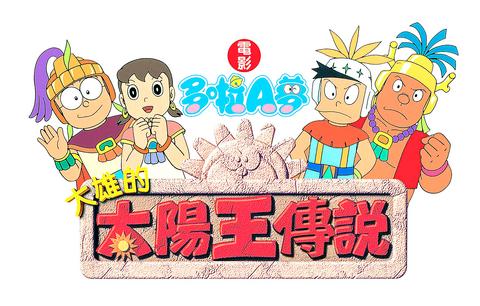In the Time Asia poll of Asian Heroes for 2002, he came out equal with Jackie Chan (
Doraemon is part of the childhoods of many Taiwanese now in their 20s and 30s, and despite the simplistic drawing style, which looks eons behind the phantasmagoria of Hollywood animation, retains its appeal for a new generation of children. The film hit the top of the box office for summer holiday screenings in Japan and Hong Kong and looks poised to do equally good business if the buzz on Internet sites is anything to go by -- and the postings are not being made by children either.

PHOTO: UIP
For those not in the know, Doraemon was born on Sept. 3, 2112, is 129.3cm tall, has a waist measurement of 129.3cm and weighs 129.3kg. He has a magic pouch in his stomach where all kinds of futuristic devices are stored. The only problem is that most of these devices don't work very well. Obviously anyone who has problems programming the VCR will sympathize with this character. His best friend is Nobita, a young knucklehead constantly being bullied by his classmates.
Like most of the great children's stories, wherever they might derive from, there is a story behind the story of the two-man team that made up Fujiko Fujio, the front man for the cartoon. While the early stories were set in suburban Japan, Doraemon is setting out on bigger and better adventures suited to the big screen.
In Doraemon, Nobita and the Legend of the Sun King the two main characters go through a "hole in time" and find themselves in a Mayan kingdom where there is intrigue over the royal succession, giving Doraemon the chance to utilize favorite devices such as the takekoputa (a rotor worn on the head, one of the truly inspired Doraemon merchandizing products) and the dokodemo door, which allows Nobita and Doraemon to go anywhere they want. This bigger setting doesn't seem to have affected the essential simplicity of the story and the attractiveness of the characters.
The perennial appeal of this character, according to Pico Iyer, travel writer and social commentator, is attributable to Doraemon's perennial optimism that undermines the dark images of a technological future. The doings of Doraemon and Nobita, because of their klutzy ineptitude, comfort us in the face of an overwhelming complexity of modern living, and so Doraemon takes his place among a pantheon of characters such as Winnie the Pooh, Peter Pan and Scooby Doo, whom people never completely grow out of.
For those who don't mind the press of weekend crowds of school children, Doraemon, Nobita and the Legend of the Sun King is probably as good a window into the Asian psyche as you are likely to find in the cinemas this summer.

The Taipei Times last week reported that the rising share of seniors in the population is reshaping the nation’s housing markets. According to data from the Ministry of the Interior, about 850,000 residences were occupied by elderly people in the first quarter, including 655,000 that housed only one resident. H&B Realty chief researcher Jessica Hsu (徐佳馨), quoted in the article, said that there is rising demand for elderly-friendly housing, including units with elevators, barrier-free layouts and proximity to healthcare services. Hsu and others cited in the article highlighted the changing family residential dynamics, as children no longer live with parents,

It is jarring how differently Taiwan’s politics is portrayed in the international press compared to the local Chinese-language press. Viewed from abroad, Taiwan is seen as a geopolitical hotspot, or “The Most Dangerous Place on Earth,” as the Economist once blazoned across their cover. Meanwhile, tasked with facing down those existential threats, Taiwan’s leaders are dying their hair pink. These include former president Tsai Ing-wen (蔡英文), Vice President Hsiao Bi-khim (蕭美琴) and Kaohsiung Mayor Chen Chi-mai (陳其邁), among others. They are demonstrating what big fans they are of South Korean K-pop sensations Blackpink ahead of their concerts this weekend in Kaohsiung.

Taiwan is one of the world’s greatest per-capita consumers of seafood. Whereas the average human is thought to eat around 20kg of seafood per year, each Taiwanese gets through 27kg to 35kg of ocean delicacies annually, depending on which source you find most credible. Given the ubiquity of dishes like oyster omelet (蚵仔煎) and milkfish soup (虱目魚湯), the higher estimate may well be correct. By global standards, let alone local consumption patterns, I’m not much of a seafood fan. It’s not just a matter of taste, although that’s part of it. What I’ve read about the environmental impact of the

Oct 20 to Oct 26 After a day of fighting, the Japanese Army’s Second Division was resting when a curious delegation of two Scotsmen and 19 Taiwanese approached their camp. It was Oct. 20, 1895, and the troops had reached Taiye Village (太爺庄) in today’s Hunei District (湖內), Kaohsiung, just 10km away from their final target of Tainan. Led by Presbyterian missionaries Thomas Barclay and Duncan Ferguson, the group informed the Japanese that resistance leader Liu Yung-fu (劉永福) had fled to China the previous night, leaving his Black Flag Army fighters behind and the city in chaos. On behalf of the